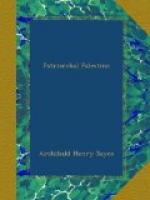We have no reason to doubt that the campaigns of Ramses III. in Asia were equally historical. The great confederacy of northern barbarians and Asiatic invaders which had poured down upon Egypt had been utterly annihilated; the Egyptian army was flushed with victory, and Syria, overrun as it had been by the invaders from the north, was in no position to resist a fresh attack. Moreover, the safety of Egypt required that Ramses should follow up the destruction of his assailants by carrying the war into Asia. But it is noticeable that the places he claims to have conquered, whether in Canaan or further north, lay along the lines of two high-roads, and that the names of the great towns even on these high-roads are for the most part conspicuously absent. The names, however, are practically those already enumerated by Ramses II., and they occur in the same order. But the list given by Ramses III. could not have been copied from the older list of Ramses II. for a very sufficient reason. In some instances the names as given by the earlier monarch are mis-spelt, letters having been omitted in them or wrong letters having been written in place of the right ones, while in the list of Ramses III. the same names are correctly written.
Seti I., the father of Ramses II., seems to have been too fully engaged in his wars in Northern Syria, and in securing the road along the coast of the Mediterranean, to attempt the re-conquest of Palestine. At Qurnah, however, we find the names of ’Aka or Acre, Zamith, Pella, Beth-el (Beth-sha-il), Inuam, Kimham (Jer. xli. 17), Kamdu, Tyre, Usu, Beth-Anath, and Carmel among those of the cities he had vanquished, but there is no trace of any occupation of Southern Canaan. That seems to have come later with the beginning of his son’s reign.
On the walls of the Ramesseum at Thebes there are pictures of the storming and capture of the Palestinian cities. Most of them are now destroyed, but we can still read the names of Ashkelon, of Salem or Jerusalem, of Beth-Anath and Qarbu[tu], of Dapul in the land of the Amorites, of Merom, of Damascus, and of Inuam. Elsewhere we have mention of Yurza and Socho, while at Karnak there are two geographical lists which mark two of the lines of march taken by the troops of Ramses II. The first list contains the following names: (1) the district of Salem; (2) the district of Rethpana; (3) the country of the Jordan; (4) Khilz; (5) Karhu; (6) Uru; (7) Abel; (8) Carmel; (9) the upper district of Tabara or Debir; (10) Shimshon; and (n) Erez Hadashta, “the new land.” In the second list we read: (1) Rosh Kadesh, or Mount Carmel; (2) Inzat; (3) Maghar; (4) Rehuza; (5) Saabata; (6) Gaza; (7) the district of Sala’; (8) the district of Zasr; (9) Jacob-el; and (10) the land of Akrith, the Ugarit of the Tel el-Amarna tablets.




